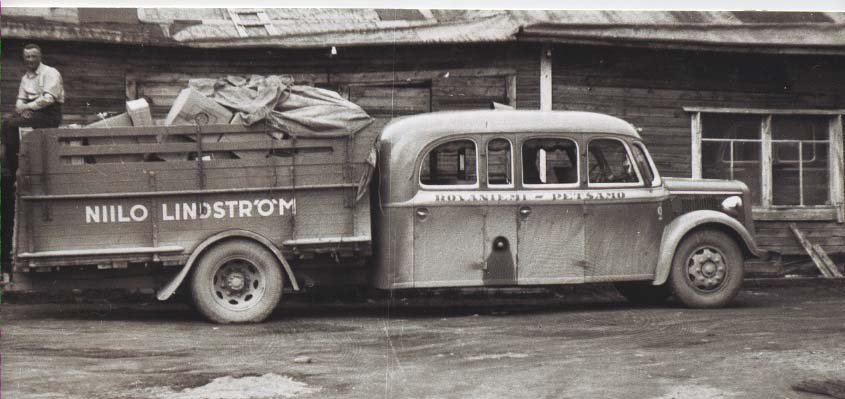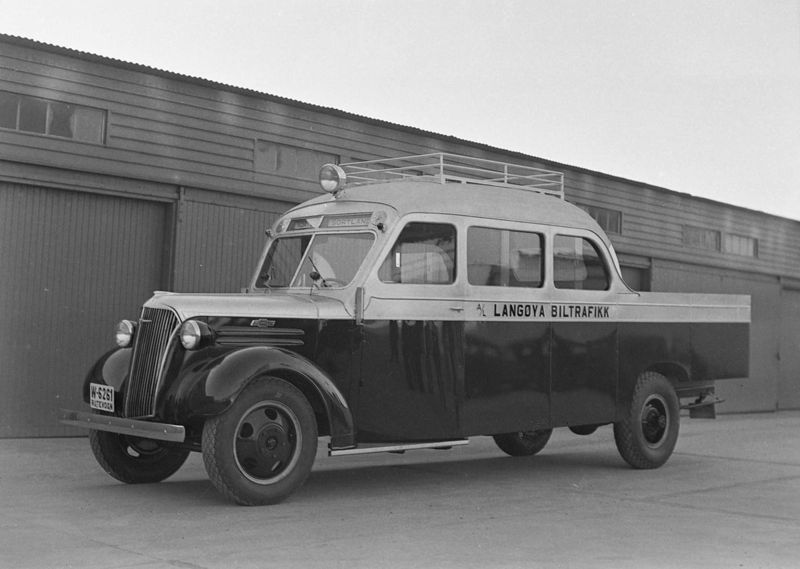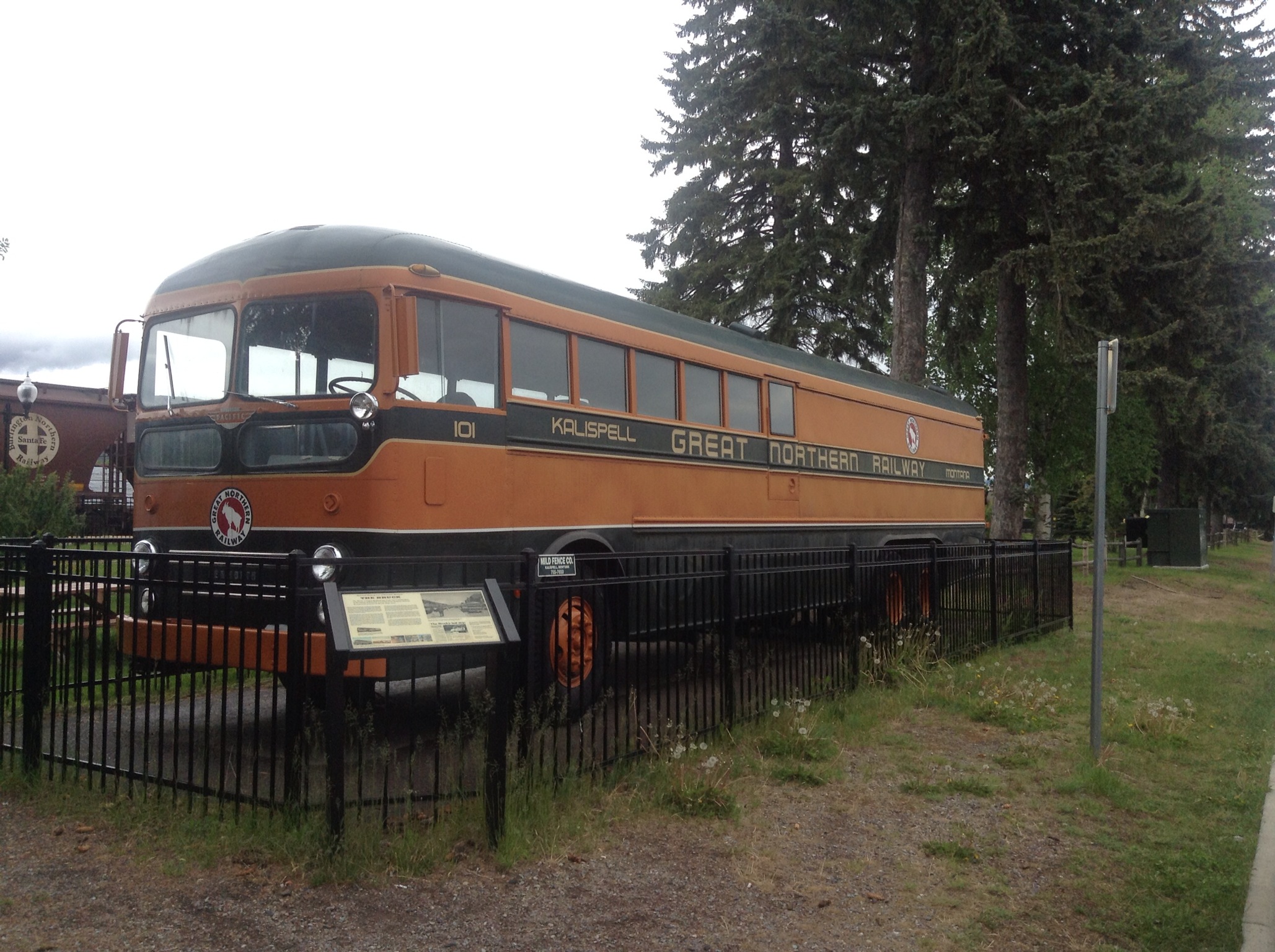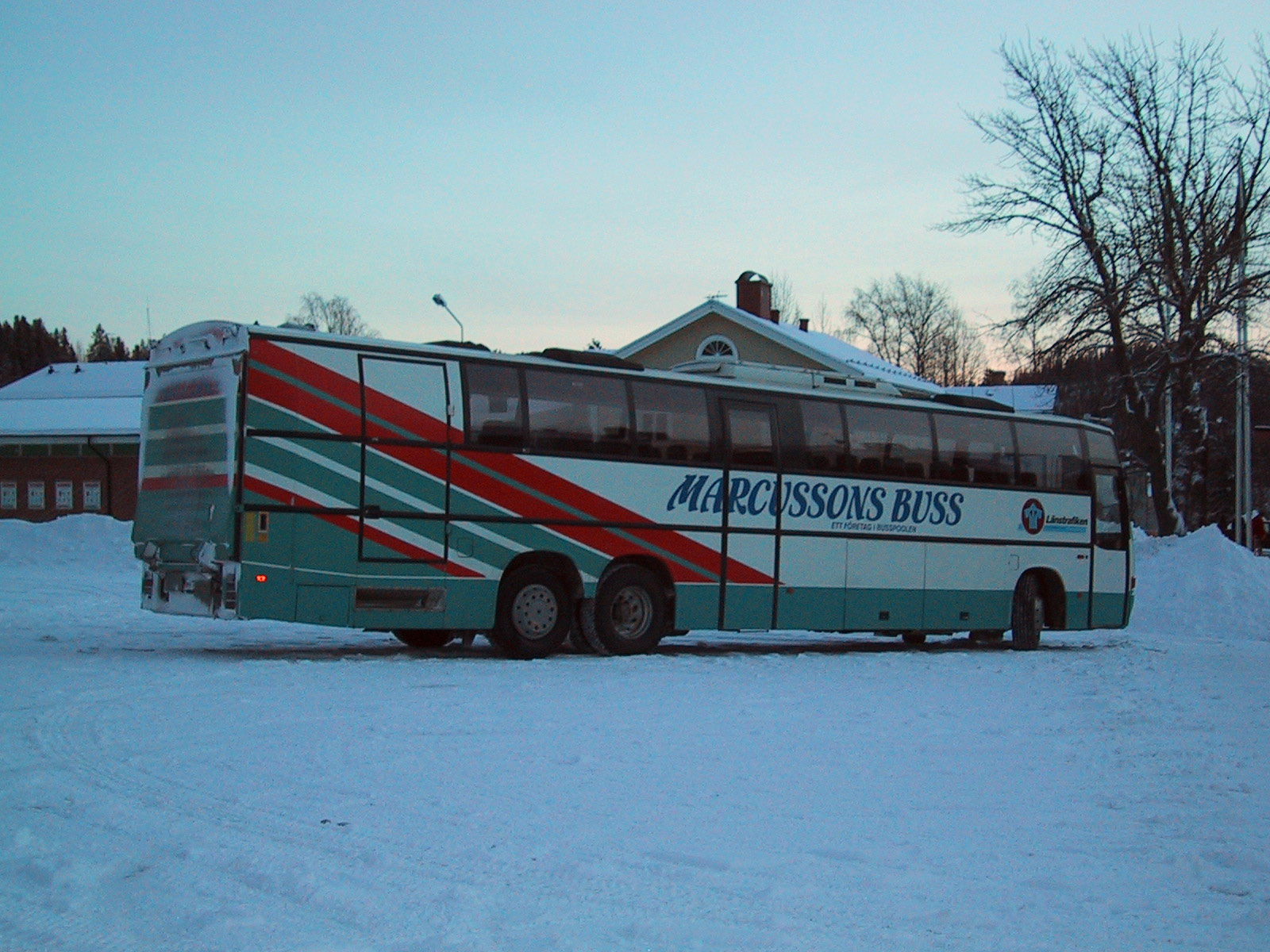Bruck (vehicle) on:
[Wikipedia]
[Google]
[Amazon]










 A bruck ( blended from the words
A bruck ( blended from the words
Bussgods Sverige
(Visited 7 May 2015)









 A bruck ( blended from the words
A bruck ( blended from the words bus
A bus (contracted from omnibus, with variants multibus, motorbus, autobus, etc.) is a road vehicle that carries significantly more passengers than an average car or van. It is most commonly used in public transport, but is also in use for cha ...
and truck
A truck or lorry is a motor vehicle designed to transport cargo, carry specialized payloads, or perform other utilitarian work. Trucks vary greatly in size, power, and configuration, but the vast majority feature body-on-frame constructi ...
) is a type of bus or coach built to combine goods and passenger transport where it is most profitable or most convenient compared to separate vehicles. The word ''bruck'' was used in North America. In Australia they were known as passenger-freighters. In Europe they are known as Kombinationsbus (German), seka-auto (Finnish), kombibuss (Norwegian) and godsbuss (Swedish), with even the nickname ''skvader
The skvader () is a Swedish fictional creature that was constructed in 1918 by the taxidermist Rudolf Granberg and is permanently displayed at the museum at Norra Berget in Sundsvall. It has the forequarters and hindlegs of a European hare (''Lep ...
''. They have for practical reasons mostly been built on front- or mid-engined chassis. In North America and Australia this type of bus was introduced in the late 1940s as a replacement for unprofitable railway lines, while in Europe they have been around since the first buses.
Concept
A bus of this type is different from an ordinary bus, in that it has a separate cargo compartment that can be either closed or open air, and is by specification built for carrying goods in route traffic. When the firstautomobile
A car or automobile is a motor vehicle with wheels. Most definitions of ''cars'' say that they run primarily on roads, seat one to eight people, have four wheels, and mainly transport people instead of goods.
The year 1886 is regarded ...
s were put into route traffic in rural areas, in many places they often took both passengers and cargo, including the mail. Many routes differentiated into separate routes using separate vehicles for every purpose, but some remained multi-purpose routes. Very few are still operating this way. As buses started to be built on truck chassis and later on purpose-built bus chassis, this type of route needed a vehicle with the characteristics of a bruck. The first ones had open air cargo compartments for easy loading and unloading. Later models would feature a canvas roof, wooden cargo boxes, or have the cargo compartment integrated into the bus body. As demands for cargo and passenger transport varied, some buses had only a small cargo compartment, while others were more or less built as a crew-cab truck offering only a few passenger seats. From the early 1980s, cantilever tail lifts have become standard equipment on brucks, making loading and unloading a one-man operation. From the 1990s the cargo compartments have gradually become more boxy and taller than the rest of the bus for maximum capacity.
In general, most brucks have been front- or mid-engined to make best possible use of the cargo space in the rear end, and to make loading height as low as possible, in addition to a better weight distribution. In the Nordic countries front-engined chassis from Volvo
The Volvo Group ( sv, Volvokoncernen; legally Aktiebolaget Volvo, shortened to AB Volvo, stylized as VOLVO) is a Swedish multinational manufacturing corporation headquartered in Gothenburg. While its core activity is the production, distributio ...
and Scania
Scania, also known by its native name of Skåne (, ), is the southernmost of the historical provinces (''landskap'') of Sweden. Located in the south tip of the geographical region of Götaland, the province is roughly conterminous with Skån ...
were the most common, while many were built on Mercedes-Benz
Mercedes-Benz (), commonly referred to as Mercedes and sometimes as Benz, is a German luxury and commercial vehicle automotive brand established in 1926. Mercedes-Benz AG (a Mercedes-Benz Group subsidiary established in 2019) is headquarte ...
and DAF
Daf ( fa, دف) also known as Dâyere and Riq is a Middle Eastern (mainly Iranian) frame drum musical instrument, used in popular and classical music in South and Central Asia. It is also used in Afghanistan, Azerbaijan, Tajikistan, Iran, Uzbe ...
chassis too. When the front-engined chassis models disappeared from the European market in the early 1980s, mid-engined chassis from Volvo and DAF became the usual choice. A few were also built on rear-engined chassis from Scania, including some tall doubledeckers in Sweden being bodied by Helmark Carosseri and Van Hool
Van Hool NV () is a Belgium, Belgian family-owned coachbuilder and manufacturer of buses, Coach (bus), coaches, trolleybuses, and Semi-trailer, trailers.
Most of the buses and coaches are built entirely by Van Hool, with engines and axle ...
. DAF stopped making mid-engined chassis in mid-1990s, so from then on brucks were almost exclusively built on Volvo chassis. With bus manufacturers taking over manufacturing of both chassis and body, the Volvo 9700
The Volvo 9700 is a range of coaches manufactured by Volvo. It was introduced in 2001 as a replacement for the Carrus Star and Vector/Regal models. There are three main models in different heights; 9700S (3.42 m), 9700H (3.61 m) and 9700HD (3.73 ...
became the most common bruck model in the 2000s. Since Volvo also stopped making mid-engined chassis in late 2009, the production of brucks has dropped. Only around 40 rear-engined brucks have been delivered to Sweden since then. As of March 2015, the last known brucks were delivered to Swedish operator Bergvalls Busstrafik in June 2014.
Reuse
Brucks are often quite popular on the second hand market, as their unique construction is handy for many different uses. In unconverted form, they can be used by charitable organizations, as band buses, for touring theatre troops, or any group of people needing space for heavy and voluminous luggage. In converted form they are popular for motorsports, where one can use it as a mobile garage. They are also popular to convert to mobile homes, with enough luggage space for most people. They can also be converted to transport horses.History
North America
Canada
The first brucks in North America were introduced in Canada byWestern Flyer Coach
New Flyer is a Canadian multinational bus manufacturer, specializing in the production of transit buses. New Flyer is owned by the NFI Group, a holding company for several bus manufacturers. New Flyer has several manufacturing facilities in Can ...
in 1943. This is also where the word ''bruck'' comes from. The company built both new brucks, and some were rebuilt from other buses, for Canadian Coachways, who operated a number of these in the far north. They had a storage compartment accessible from the outside by a rear door, replacing the last rows of seats.
United States
In the United States, the brucks were introduced in 1951, whenKenworth
Kenworth Truck Company is an American truck manufacturer. Founded in 1923 as the successor to Gersix Motor Company, Kenworth specializes in production of heavy-duty ( Class 8) and medium-duty (Class 5–7) commercial vehicles. Headquartered in ...
built a tri-axle one for Northern Pacific Railroad
The Northern Pacific Railway was a transcontinental railroad that operated across the northern tier of the western United States, from Minnesota to the Pacific Northwest. It was approved by Congress in 1864 and given nearly of land grants, whi ...
, which had a front part for 17 passengers and a taller, 18 ft long cargo compartment and a 136 hp Hall-Scott engine. Brucks were also available from Crown Coach
The Crown Coach Corporation (founded as the Crown Carriage Company) is a defunct American bus manufacturer. Founded in 1904, the company was best known for its Supercoach range of yellow school buses and motorcoaches; the former vehicles were ...
, both as a 40 ft tri-axle carrying 20 passengers and with a 20 ft cargo compartment, or as a shorter 35 ft two-axle with 12 seats.
Kenworth also delivered a batch of twelve tri-axle brucks to Great Northern Railway in Montana
Montana () is a state in the Mountain West division of the Western United States. It is bordered by Idaho to the west, North Dakota and South Dakota to the east, Wyoming to the south, and the Canadian provinces of Alberta, British Columb ...
, where the front half was based on the Kenworth Model T-126 SchoolCoach body, while the second half was custom built. They were fitted with a Hall-Scott
Hall-Scott Motor Car Company was an American manufacturing company based in Berkeley, California. It was among the most significant builders of water-cooled aircraft engines before World War I.
History
1910–21
The company was founded in 1910 ...
under-floor "pancake" engine. One of these, that had been doing the local route from Kalispell
Kalispell (, Montana Salish: Ql̓ispé, Kutenai language: kqayaqawakⱡuʔnam) is a city in, and the county seat of, Flathead County, Montana, United States. The 2020 census put Kalispell's population at 24,558. In Montana's northwest region ...
to Whitefish and Columbia Falls between 1951 and 1971, have been preserved and is exhibited at the Whitefish Depot Whitefish or white fish may refer to:
* Whitefish (fisheries term), referring to the flesh of many types of fishes
Aquatic life Fish species are
* Cape whitefish, ''Pseudobarbus capensis'', a cyprinid
* Beluga sturgeon, ''Huso huso''
* Cas ...
.
Australia
In Australia they were known as ''passenger-freighters'', and were introduced byWestern Australian Government Railways
Western Australian Government Railways (WAGR) was the operator of railway services in the state of Western Australia between October 1890 and June 2003. Owned by the state government, it was renamed a number of times to reflect extra responsi ...
in 1949, as a substitute to railway lines that had been closed. The first ones were built on Foden PVSC6 chassis with Gardner six-cylinder diesel engines. They were green and cream in livery. Later they were built on rear-engined Hino RC320P chassis.
Germany
In 1907, Karl Kässbohrer Fahrzeugwerke inUlm
Ulm () is a city in the German state of Baden-Württemberg, situated on the river Danube on the border with Bavaria. The city, which has an estimated population of more than 126,000 (2018), forms an urban district of its own (german: link=no, ...
built the first "Kombinationsbus". It had a wooden bodywork built on a Saurer
Adolph Saurer AG was a Swiss manufacturer of embroidery and textile machines, trucks and buses under the Saurer and Berna (beginning in 1929) brand names. Based in Arbon, Switzerland, the firm was active between 1903 and 1982. Their vehicles we ...
truck chassis. Unlike other types of brucks, it had sideways-mounted folding seats so that the same space could be used for either cargo or passengers, and probably a combination too. Kässbohrer received a patent for this in 1910. It could accommodate 18 seated and ten standing passengers. It was used by a guest house
A guest house (also guesthouse) is a kind of lodging. In some parts of the world (such as the Caribbean), guest houses are a type of inexpensive hotel-like lodging. In others, it is a private home that has been converted for the exclusive use ...
for carrying beer keg
A keg is a small barrel.
Wooden kegs made by a cooper were used to transport nails, gunpowder, and a variety of liquids.
A keg is normally now constructed of stainless steel, although aluminium can be used if it is coated with plastic on t ...
s and also passengers.
Since 2011, a cargo service by bus is offered in the Uckermark
The Uckermark () is a historical region in northeastern Germany, straddles the Uckermark District of Brandenburg and the Vorpommern-Greifswald District of Mecklenburg-Vorpommern. Its traditional capital is Prenzlau.
Geography
The region is nam ...
district, named ''kombiBUS''. The service is however operated with conventional buses with underfloor luggage compartments and with trailers, so they have technically little in common with actual brucks.
Nordic countries
In Finland, Norway and Sweden, brucks were quite common in the rural parts at the beginning of the 20th century. They were a good option not only where building a railway was not economically feasible, but also where the railwaybuilders had yet to arrive or where the landscape didn't allow for any railway line. For many years the transport of milk churns between farms and dairies was one of the major uses, but as milk tank trucks became common, this was no longer needed. The manual loading and unloading of milk churns was one of the main reasons for an open air compartment, and when this was not a factor anymore, brucks started to become more like the modern versions.Finland
Today only one Finnish bus operator, theRovaniemi
Rovaniemi ( , ; sme, Roavvenjárga ; smn, Ruávinjargâ; sms, Ruäʹvnjargg) is a city and municipality of Finland. It is the administrative capital and commercial centre of Finland's northernmost province, Lapland, and its southern part Pe ...
-based Gold Line (subsidiary of Koiviston Auto), use modern type brucks with tail lift in route traffic. However some other operators also use buses and coaches where the rearmost metre or two is a walk-in cargo compartment with shelves. This compartment can be entered by a large door either on the door side or from the rear side.
Norway
In Norway, brucks are known as "kombibuss", or alternatively "kombinertbuss". With the exception of highly populated areas aroundOslo
Oslo ( , , or ; sma, Oslove) is the capital and most populous city of Norway. It constitutes both a county and a municipality. The municipality of Oslo had a population of in 2022, while the city's greater urban area had a population of ...
, including areas where railway lines had been built in the late 19th century, brucks could be found in most of the country up to the 1980s, when standardised buses started to become more common, and the costly brucks were considered ineffective.
Norway's national touring theatre, Riksteatret
Riksteatret (English: National Traveling Theater) is a Norwegian touring theatre. It was established by law in 1948. Its first performance was in Kirkenes
Kirkenes (; ; Skolt Sami: ''Ǩeârkknjargg;'' fi, Kirkkoniemi; ; russian: Киркене ...
, has for many years used brucks when touring the country, and for a long time it was Førde
Førde is a former municipality in the county of Sogn og Fjordane, Norway. It was located in the traditional district of Sunnfjord. The administrative center was the town of Førde which in 2016 had 10,255 inhabitants. Other villages in Førd ...
-based operator Firda Billag who operated the buses. However, from 1 January 2009 they have been operated by Nordreisa
Nordreisa ( se, Ráisa ; fkv, Raisi) is a municipality in Troms og Finnmark county, Norway. The administrative centre of the municipality is the village of Storslett. Other villages include Oksfjordhamn, Sørkjosen, and Rotsund.
The municip ...
/Tromsø
Tromsø (, , ; se, Romsa ; fkv, Tromssa; sv, Tromsö) is a municipality in Troms og Finnmark county, Norway. The administrative centre of the municipality is the city of Tromsø.
Tromsø lies in Northern Norway. The municipality is the ...
-based coach operator Bussring. Bussring bought one brucks second hand and ordered four new bruck coaches for the assignment. Contrary to all other brucks, these four that they ordered were never intended for use in route traffic, yet they are built to the same specifications. In 2014 they also bought one second hand from Firda Billag.
Firda Billag used to be one of the major bruck operators in Norway with over a dozen brucks in service, but in 2010/2011 they decided to sell the brucks and instead buy mini- and midibuses for the passenger traffic and trucks for the cargo. The passenger and cargo operations were also split into separate subsidiaries.
As of May 2015, brucks can mostly be found in the far north and along the west coast. In addition, two operators in Telemark
Telemark is a traditional region, a former county, and a current electoral district in southern Norway. In 2020, Telemark merged with the former county of Vestfold to form the county of Vestfold og Telemark. Telemark borders the traditional ...
operate brucks; Drangedal Bilruter operate one bruck between Tørdal
Tørdal is a district in Drangedal municipality, in the county Vestfold og Telemark, Norway
Norway, officially the Kingdom of Norway, is a Nordic country in Northern Europe, the mainland territory of which comprises the western and nor ...
and Drangedal Station
Drangedal Station ( no, Drangedal stasjon) is a railway station located in Prestestranda in Drangedal, Norway on Sørlandet Line. The station is served by express trains to Kristiansand and Oslo
Oslo ( , , or ; sma, Oslove) is the capita ...
, while Telemark Bilruter
Telemark Bilruter AS is a Norway, Norwegian bus company based in Vestfold og Telemark with headquarters in Seljord. The company operates regional and express buses, and through subsidiaries also trucks. They operate routes in the municipalities o ...
operate three bruck lines with a total of five bruck. The three lines are Åmot-Haukeli
Haukeli (or historically ''Haukeligrend'') is a village in Vinje Municipality in Vestfold og Telemark county, Norway. The village is located up in the Haukelifjell mountains, just south of the Hardangervidda National Park and immediately west of ...
, Fyresdal
Fyresdal is a municipality in Telemark in the county of Vestfold og Telemark in Norway. It is part of the traditional region of Vest-Telemark. The administrative centre of the municipality is the village of Moland. The municipality of ''Molan ...
-Vrådal
Vrådal, formerly spelled Wraadahl, is a village in Kviteseid municipality, Norway
Norway, officially the Kingdom of Norway, is a Nordic country in Northern Europe, the mainland territory of which comprises the western and northernmost ...
- Seljord and Vrådal
Vrådal, formerly spelled Wraadahl, is a village in Kviteseid municipality, Norway
Norway, officially the Kingdom of Norway, is a Nordic country in Northern Europe, the mainland territory of which comprises the western and northernmost ...
-Arendal
Arendal () is a municipality in Agder county in southeastern Norway. Arendal belongs to the region of Sørlandet. The administrative centre of the municipality is the city of Arendal (which is also the seat of Agder county). Some of the notab ...
.
Sweden
In the 1950s and 1960s, the brucks in Sweden received the nicknameskvader
The skvader () is a Swedish fictional creature that was constructed in 1918 by the taxidermist Rudolf Granberg and is permanently displayed at the museum at Norra Berget in Sundsvall. It has the forequarters and hindlegs of a European hare (''Lep ...
, because of their unlikely appearance as two widely different things put together as one, just as the origin of the word "skvader". In more recent years the brucks in Sweden are known exclusively by the word "godsbuss".
The largest population of brucks in the world has most likely always been and still is in Sweden, where they are still used on many long distance routes in the northern parts of the country. Sweden has also seen some special bruck construction. The largest are the nearly 15 metres long and 4.2 metres tall double-decker brucks that have been bodied by Helmark Carosseri and Van Hool. Earlier Van Hool have also bodied some quad-axle articulated brucks, where the passenger compartment and the cargo compartment were separated by the articulation joint. Some of these were later exported to Russia.
Sending of packets and goods with brucks in Sweden is organised through the brand ''Bussgods'', where both private customers and business customers can send different types of letters and packets or larger types of cargo by bus throughout the entire country. This includes both routes run with brucks and routes run with conventional buses and coaches or with trucks. The Bussgods logo is visible on the majority of Swedish brucks in operation today.(Visited 7 May 2015)
References
External links
* {{buses Buses by type Trucks